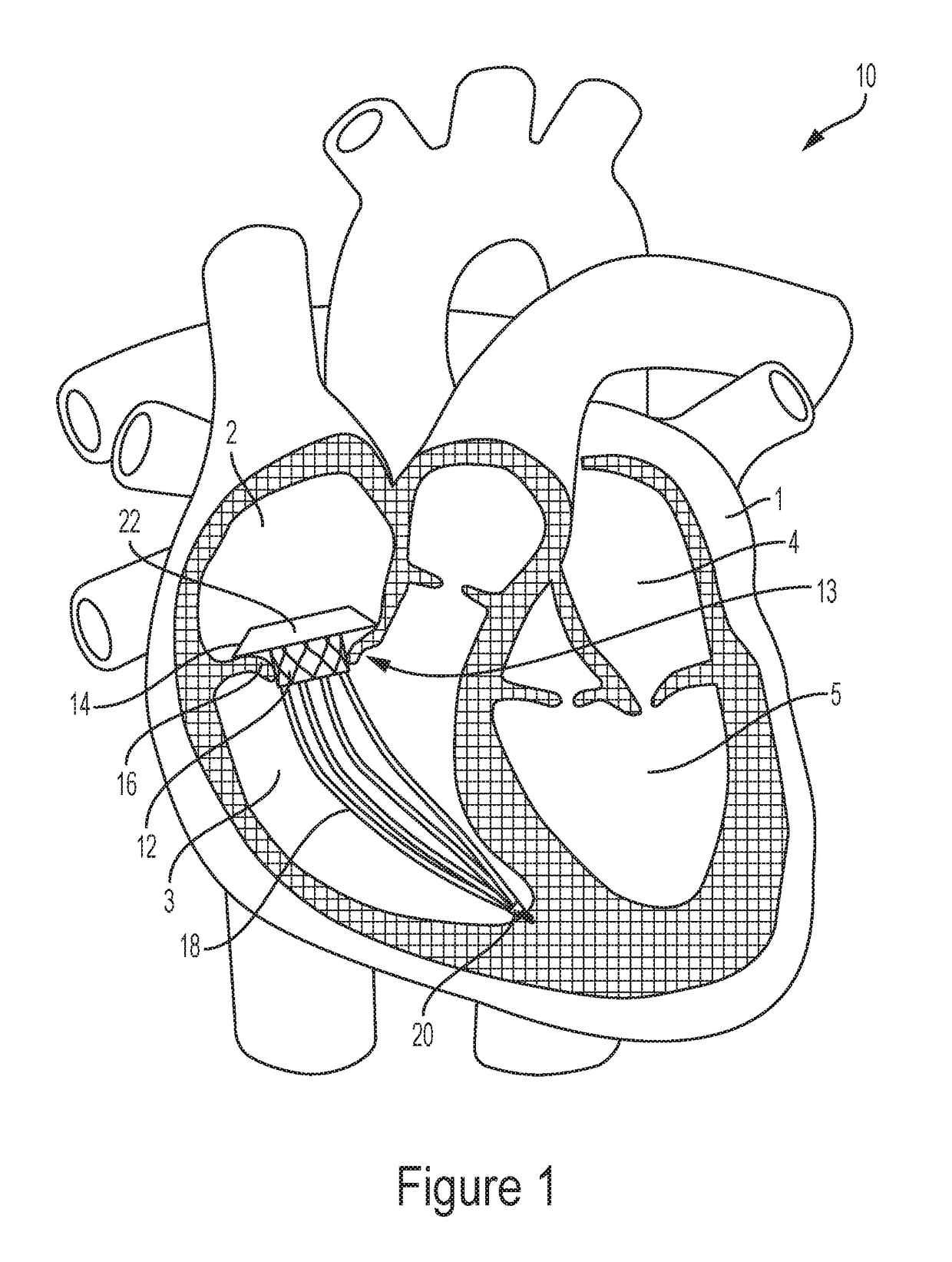Although tested extensively for replacement of aortic, mitral, and pulmonic valves, less experience exists for replacement of tricuspid valves given the complex and delicate
anatomy to which prostheses must anchor.
Also, anchoring either in the in-situ position of cardiac valves or in other body lumens remains challenging given great heterogeneity in shapes and sizes of either cardiac valve annuli or other lumens.
In this regard, treatment of
tricuspid valve regurgitation remains the most challenging, and fewer transcatheter treatments have been developed.
Additionally, persistent
right heart volume overload from TR leads to progressive right ventricular dilation and failure, increasing mortality.
In one animal the valve was trapped in tricuspid cordae, and in another animal the valve had significant paravalvular regurgitation, raising concerns about this approach.
Inherently, such as broad range in size results in uncertain durability and function, and limits widespread application given need for individual customization.
Laule's technique of using a commercially available transcatheter valve, the Sapien valve (with its known performance and durability in thousands of patients), partially solves this, but is limited by seating difficulties and paravalvular regurgitation that would result from implantation in SVCs or IVCs bigger than the largest Sapien valve—29 mm, which occurs commonly in patients with TR.
Similarly, other currently available valves cannot work in SVC / IVC diameters bigger than 30-31 mm.
Nonetheless, the caval valve solutions outlined in [0006-0009 and 0011] suffer this same limitation; specifically, IVC and / or SVC
stent valves do not completely restore the function of the
tricuspid valve because they are not placed in the anatomically correct position—across the tricuspid annulus.
Hence, they palliate symptoms but do not fundamentally address right
ventricle (RV) volume overload caused by TR.
To address volume overload, intra-annular anchoring of a valve across the native tricuspid valve is required; the above techniques are not suitable for intra-annular anchoring of transcatheter valves given the fragile and complex
paraboloid annular
anatomy of the tricuspid annulus, along with large and flared anchoring zones in the atria and ventricles connected to the annuli.
Although investigators have developed docking systems to aid in intra-annular anchoring of transcatheter valves, these techniques are less likely to work for the tricuspid valve for several reasons.
Although effective in this location, this platform would not remain anchored in a tricuspid annulus; unlike the aortic annulus, the tricuspid annulus has a complex
paraboloid shape, easy distensibility, and lack of
calcium, which could preclude the Helio dock, a simple tubular structure, from remaining in place.
Given the
fragility of this annulus, any
metal docking
system, even while using a compliant
metal such as Nitinol, has a higher risk of
erosion around the tricuspid annulus than any other valvular annulus.
Moreover, any rigid or semi-rigid anchoring device is likely to have malposition over time given that any tricuspid annulus can dilate over the course of weeks.
Nonetheless, these approaches have limitations.
Moreover, any further RV remodeling with leaflet
tethering would cause recurrent TR despite annular reduction.
The same limitations apply to the TriCinch device, which also has the downside of requiring a
stent in the IVC.
Although the Cardioband device provides more complete annular reduction, it also leaves
moderate to severe TR, and is less effective in the presence of leaflet abnormalities or intracardiac leads.
Finally, the Millipede device, with its complete ring, provides the greatest annular reduction, but once again does not address leaflet abnormalities or intracardiac leads.
Both devices, however, suffer significant limitations.
Furthermore, initial human experience has demonstrated a high major adverse event rate, including anchor dislodgement, pericardial
tamponade, and emergent
cardiac surgery.
Tricuspid clipping with the MitraClip system is technically demanding with uncertain reproducibility, and
moderate to severe residual TR is common.
Like annuloplasty techniques, the Forma Repair system and the MitraClip cannot treat TR effectively in the presence of significant leaflet abnormalities or
pacemaker leads.
This valve, however, requires trans-apical access to the
ventricle, which would be a very high-risk approach to the right
ventricle.
Additionally, many TR patients suffer right ventricular dysfunction, and a fixed tether to the right ventricular myocardium could, via physical restraint or induction of scarring, further compromise right
ventricular function.
Furthermore, NaviGate's annular anchoring mechanism requires a large valve, necessitating a very large delivery system, which limits truly
percutaneous delivery to select patients.
The
large size of NaviGate also precludes it from being used as a docking system for commercially available transcatheter valves in the event of its structural deterioration.
Finally, given that it requires full expansion against the annulus, it is unlikely this valve can be implanted in the presence of prior tricuspid leaflet clipping with the MitraClip, and is it likely this valve would damage any pre-existing intracardiac leads going across the tricuspid valve.
 Login to View More
Login to View More  Login to View More
Login to View More 


